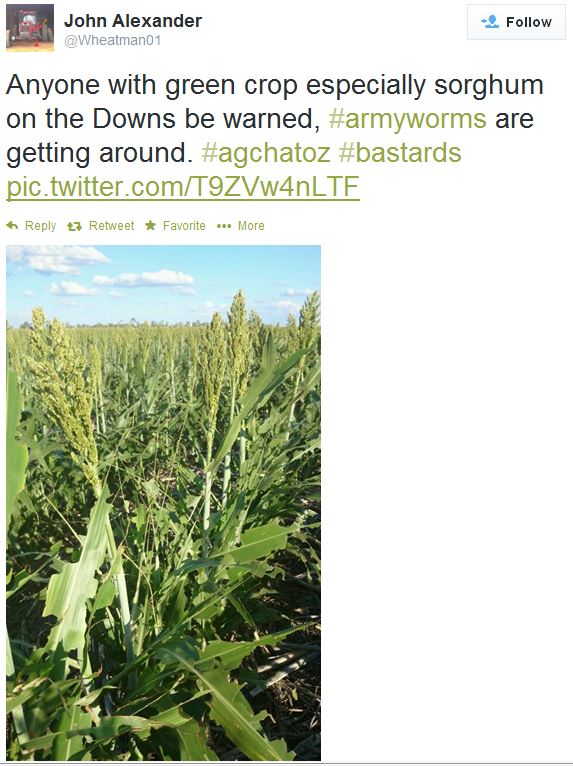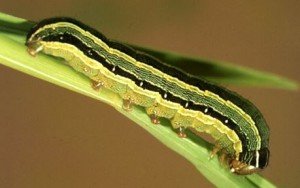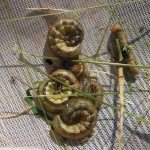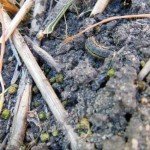On the Darling Downs there have been a number of reports of common armyworm causing significant defoliation in sorghum, corn and millet. Jimbour grower John Alexander treated a severely defoliated sorghum crop two weeks ago. Millet and corn crops in the same area have also been affected. Although patchy, the outbreaks have the potential to cause significant yield loss if the armyworm defoliate before the crop has reached physiological maturity.

Recent tweet from the Downs showing extent of defoliation to late sorghum.
At this time of year, high numbers of common armyworm and dayfeeding armyworm can defoliate seedling crops, summer crops that are still green as well as pasture. The common armyworm is the same species of armyworm that causes damage to winter cereals in spring, and the high numbers now may be a carryover from the outbreak in northern NSW last spring. Outbreaks for dayfeeding armyworm have been recorded in crops and pasture in late March and April in previous years. The last major outbreak of dayfeeding armyworm (Spodoptera exempta) was in 2003, and prior to that in the 1970s. Dayfeeding armyworm will attack both crops and the grass component of pasture. Control of armyworm in pasture has to be undertaken with careful consideration for withholding periods for stock, particularly export grazing and slaughter intervals which generally are not on the label.

Dayfeeding armyworm larva
Both the common and dayfeeding armyworm larvae look similar to Helicoverpa larvae. Correct identification is important because armyworm cannot be controlled with NPV, and helicoverpa have resistance to synthetic pyrethroids (the two most commonly used control options for these species). For identification of common armyworm refer to a previous beat sheet posting. When dayfeeding armyworm larvae develop under crowded conditions, as in outbreaks, the larvae have a distinctive blue-black colouration and are inclined to excessive movement. The name dayfeeding armyworm is because outbreak populations will move and feed during daylight hours. Typically, armyworm are active at night, sheltering during the day in the crop canopy or under stubble on the soil surface.
Armyworm outbreaks like these tend to last only 1 to 2 generations as disease, predation and parasitism have an impact on survival. The threat to winter crops is expected to be low, but monitoring as the crops emerge, particularly in proximity to armyworm outbreaks now, is recommended.
Considerations in the event of armyworm outbreaks:
Size of the larvae. Eighty percent of feeding is done by medium to large larvae. If the armyworms are longer than 30 to 35mm, they have completed most of their feeding and the damage is already done. Treating at this stage may be of little benefit. To be effective, populations need to be detected and controlled before large larvae have caused significant defoliation.
Threshold? Specific thresholds have not been established for defoliating armyworm in sorghum or corn in Australia. US data suggests controlling armyworm when crops have more than 50% defoliation.
Timing of control. With the common armyworm, small larvae may feed during the day, but large armyworm feed at night and shelter on the ground under stubble and soil during the day. Applying a treatment later in the day maximizes the likelihood of contacting large, damaging larvae as they climb the plants to feed. Control options can be found on the APVMA website. Control of dayfeeding armyworm is straightforward.
Good coverage is required to get contact with the caterpillars, particularly in crops with thick canopies.
If treating pastures beware of the long withholding periods for cattle grazed on this pasture with reference to export slaughter intervals and export grazing intervals. These intervals are not always marked on insecticide labels.
Natural enemies
Around 20 species of predator and parasitoids have been recorded attacking armyworm, but they are unlikely to prevent damage in an outbreak situation like those being reported.
The most frequently observed predators are predatory shield bugs, ladybeetles, carabid beetles, lacewings and common brown earwigs.
Parasitoids include tachnid flies and a number of wasp species (e.g. Netelia, Lissopimpla, Campoletis).
Viral and fungal diseases can also cause mortality of armyworm. Such outbreaks are more common at high armyworm densities.
Click onto images to enlarge
Article by Kate Charleston and Melina Miles



Comment from Paul McIntosh (Landmark) on 17 April 2004
It will not differ in control or spotting, but they are the daytime feeding species and they are truly daytime feeders and movers, as they literally came marching up the paddock track towards me out of the millet crop